Intel NUC 12 Pro Wall Street Canyon Kits Review: Alder Lake in UCFF Avatar
by Ganesh T S on January 26, 2023 11:30 AM ESTGPU Performance: Synthetic Benchmarks
Intel did not make significant changes in the integrated GPU when moving from Tiger Lake to Alder Lake. Process maturity has allowed it to clock the iGPU a bit higher, but the number of EUs remains the same as in the previous generation. GPU performance evaluation typically involved gaming workloads, and for select PCs, GPU compute. Prior to that, a look at the capabilities of the GPU in the NUC 12 Pro kits is warranted.
The Intel Iris Xe Graphics in the NUC 12 Pro kits is an integrated GPU based on a reworked scalable architecture. The performance of the iGPU is miles ahead of previous iGPUs from both Intel and AMD, as the benchmarks below show.
GFXBench
The DirectX 12-based GFXBench tests from Kishonti are cross-platform, and available all the way down to smartphones. As such, they are not very taxing for discrete GPUs and modern integrated GPUs. We processed the offscreen versions of the 'Aztec Ruins' benchmark.
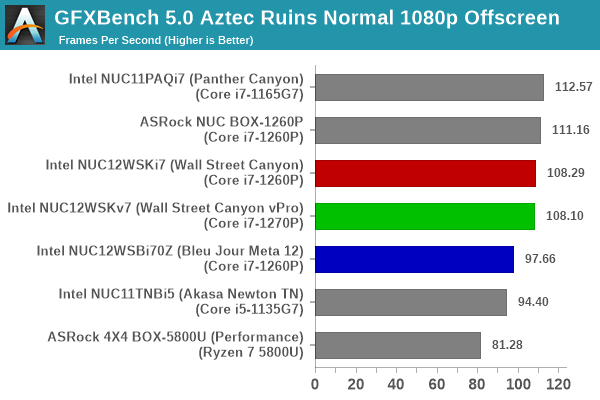
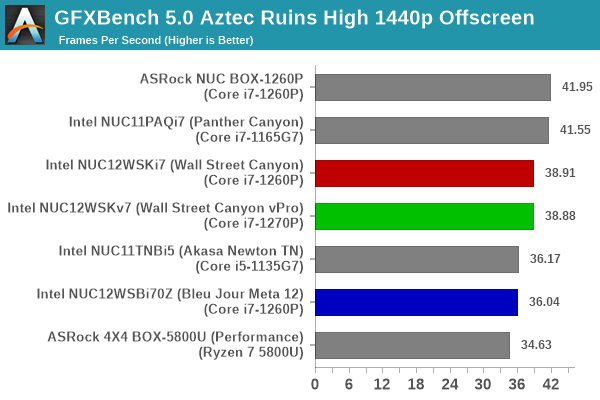
Panther Canyon has a slightly higher PL2 (67W) that gives it a bit of an edge. However, the power budget allocation in the ASRock Industrial unit to the iGPU seems to be better than the one in the NUC 12 Pro units, and that translates to the NUC 12 Pro kits coming in the middle of the pack. However, the scenario changes when offscreen considerations are dropped.
UL 3DMark
Four different workload sets were processed in 3DMark - Fire Strike, Time Spy, Night Raid, and Wild Life. The results below consistently show the actively-cooled NUC 12 Pro kits performing much better than the other systems in the mix. A combination of faster clocks and higher power budgets appear to be the reason behind this.
3DMark Fire Strike
The Fire Strike benchmark has three workloads. The base version is meant for high-performance gaming PCs. It uses DirectX 11 (feature level 11) to render frames at 1920 x 1080. The Extreme version targets 1440p gaming requirements, while the Ultra version targets 4K gaming system, and renders at 3840 x 2160. The graph below presents the overall score for the Fire Strike Extreme and Fire Strike Ultra benchmark across all the systems that are being compared.
| UL 3DMark - Fire Strike Workloads | |||
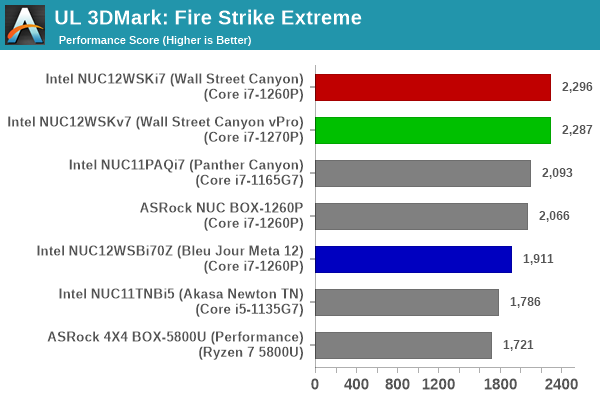
3DMark Time Spy
The Time Spy workload has two levels with different complexities. Both use DirectX 12 (feature level 11). However, the plain version targets high-performance gaming PCs with a 2560 x 1440 render resolution, while the Extreme version renders at 3840 x 2160 resolution. The graphs below present both numbers for all the systems that are being compared in this review.
| UL 3DMark - Time Spy Workloads | |||
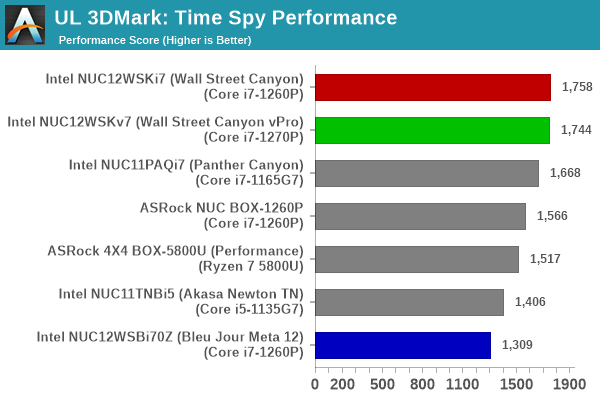
3DMark Wild Life
The Wild Life workload was initially introduced as a cross-platform GPU benchmark in 2020. It renders at a 2560 x 1440 resolution using Vulkan 1.1 APIs on Windows. It is a relatively short-running test, reflective of mobile GPU usage. In mid-2021, UL released the Wild Life Extreme workload that was a more demanding version that renders at 3840 x 2160 and runs for a much longer duration reflective of typical desktop gaming usage.
| UL 3DMark - Wild Life Workloads | |||

3DMark Night Raid
The Night Raid workload is a DirectX 12 benchmark test. It is less demanding than Time Spy, and is optimized for integrated graphics. The graph below presents the overall score in this workload for different system configurations.
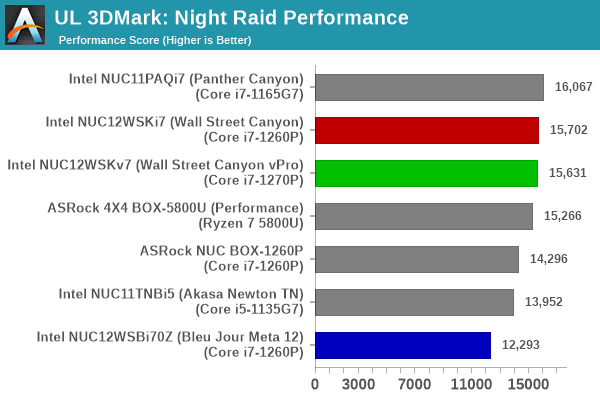











25 Comments
View All Comments
timecop1818 - Thursday, January 26, 2023 - link
vPro is usually a price premium, as it allows fully remote management in corp environment.TheinsanegamerN - Thursday, January 26, 2023 - link
It's great to see the puck nuc come back, I was worried they discontinue it. Shame they gimped it with DDR4 SODIMMS when DDR5 is widely available, especially at this price.Guess I'll wait for 14th gen when they actually jump on new memory types.
meacupla - Thursday, January 26, 2023 - link
Yeah, why would intel choose DDR4 on a platform like this? It makes zero sense.They had the option of DDR5SODIMM, DDR5CAMM, or LPDDR5, and they decide to go with DDR4SODIMM
abufrejoval - Sunday, January 29, 2023 - link
I just checked, 64GB of SO-DIMMs is still twice the price at DDR5 than DDR4. And the performance difference might be very minor for CPU workloads, especially in this form factor.Now I would like to have seen if it makes a difference for the iGPU, but then the Xe isn't meant for gaming either way.
LP variants require soldered RAM and that's one of the major advantages of this form factor: upgradable RAM. I run my NUCs as VM servers and 64GB is just a good fit for that. Try getting anything with 64GB of LPDDRx RAM!
And then again at a reasonable price.
James5mith - Friday, January 27, 2023 - link
I have an i7-1165G7 based NUC used for my pfsense firewall. It's overkill, but it has the 2x 2.5GbE NICs I wanted for my firewall upgrade.Idles extremely low power, and never really gets stressed. For 10-15w I have a 2.5GbE capable firewall that is never stressed even when using IDS/IPS.
I wish they would release an i3 with 2x 2.5GbE at some point. It would be much more suited to the role.
Einy0 - Friday, January 27, 2023 - link
The performance lag on the passive cooled version is a great example of how bad Intel's thermals have gotten. I used to put NUCs into passive cases half the size of the one used here, and they lost zero performance. It's really sad how far they've fallen.Affectionate-Bed-980 - Friday, January 27, 2023 - link
Are your specs for HDMI correct? I see HDMI 2.0 listed on some sites like Newegg but Intel's spec page says HDMI 2.1https://www.intel.com/content/www/us/en/products/s...
https://www.intel.com/content/www/us/en/products/s...
PeachNCream - Friday, January 27, 2023 - link
The problem with NUCs is that, after buying a screen, keyboard, and mouse, to get to a working system, you could have just purchased a laptop. NUCs don't offer mobility and aren't compelling from a performance perspective since they're using laptop-like TDP limits so you end up buying a desktop PC with laptop performance that you cannot use as flexibly as a laptop despite spending roughly the same amount. NUCs have niche uses, but the reason why they aren't popular is because that niche is rather narrow.white-hot - Friday, January 27, 2023 - link
I have been using them for years as HTPC's in various locations in my house. In general they have been fine up until recently when I began streaming high bit-rate 4K video and they really don't like it. Granted they are all i3's of several generations old now, but other than that they do fine. I have a home media server that delivers video to these units, but rather than upgrade for 4K use I am currently trying plex via a fire stick and/or smart TV. The video stream is better but the interface is so slow. Not sure where I will end up, but having a NUC velcroed to the back of a TV has been very nice up till now.Hakaslak - Saturday, January 28, 2023 - link
Does Quick Sync work for you? Maybe a newer NUC with hardware accelerated transcoding would be what you're looking for? The new ones have 2 multi-format codec engines and quick synchttps://www.intel.com/content/www/us/en/products/s...